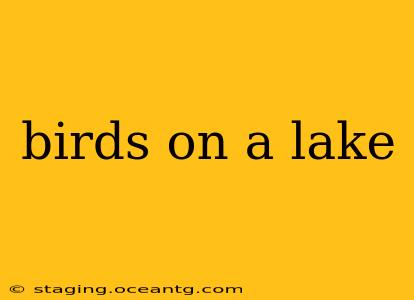Lakes are vibrant ecosystems teeming with life, and birds often play a central role. From majestic waterfowl to smaller, more secretive species, a wide variety of avian life can be found thriving around and on the water's surface. This article delves into the fascinating world of birds on lakes, exploring their diverse roles, behaviors, and the factors that influence their presence.
What Types of Birds Live on Lakes?
The types of birds found on a lake depend heavily on its size, location, surrounding habitat, and the season. However, some common groups include:
-
Waterfowl: Ducks, geese, and swans are iconic lake inhabitants. Different species have varying preferences for habitat, some preferring open water while others favor areas with emergent vegetation. Mallards, Canada geese, and Mute swans are frequently seen examples.
-
Wading Birds: Herons, egrets, and ibises are skilled hunters that stalk shallows and edges of lakes, using their long legs and necks to capture fish, amphibians, and insects. Great Blue Herons and various egret species are often spotted.
-
Shorebirds: While not always directly on the lake, shorebirds frequently utilize the lake's shoreline for foraging. These birds, like sandpipers and plovers, often probe the mudflats for invertebrates.
-
Diving Birds: Loons, grebes, and some ducks are exceptional divers, pursuing prey beneath the water's surface. Loons are particularly associated with larger, deeper lakes.
-
Birds of Prey: Osprey, bald eagles, and hawks frequently patrol lakes, hunting fish and other avian inhabitants. Their presence is an indicator of a healthy ecosystem.
Why Do Birds Live on Lakes?
Lakes provide a rich and abundant food source for birds. Insects, fish, amphibians, and aquatic plants provide sustenance for a diverse array of species. Furthermore, lakes offer:
-
Shelter: Reeds, rushes, and other aquatic vegetation provide nesting sites and refuge from predators. The water itself can offer escape from terrestrial predators.
-
Breeding Grounds: The relative safety and abundant food resources of lakes make them ideal locations for birds to raise their young.
-
Migration Stopover: Many migratory birds use lakes as vital resting and refueling points during their long journeys.
What Do Birds Eat on a Lake?
The diet of lake birds is incredibly varied and depends on the species and its hunting strategies. Common food sources include:
-
Fish: Many diving birds and wading birds rely heavily on fish as their primary food source.
-
Insects: Both aquatic and terrestrial insects are consumed by a wide range of birds, including shorebirds and some waterfowl.
-
Plants: Some waterfowl and other birds consume aquatic plants, seeds, and berries.
-
Amphibians: Frogs and other amphibians are prey for some wading birds.
-
Other Birds: Birds of prey will hunt smaller birds, adding to the complexity of the lake ecosystem.
What Are the Threats to Birds on Lakes?
Unfortunately, several threats impact bird populations around lakes:
-
Habitat Loss: Development and pollution can severely reduce the availability of suitable habitat.
-
Pollution: Pesticides, heavy metals, and other pollutants can contaminate the water and food sources, harming birds.
-
Predation: Both natural predators and introduced species can negatively affect bird populations.
-
Climate Change: Changes in temperature and precipitation patterns can disrupt breeding cycles and food availability.
-
Human Disturbance: Recreational activities and human encroachment can stress birds and impact their breeding success.
How Can I Help Birds on Lakes?
Protecting and enhancing lake ecosystems is vital for the survival of avian life. Here are some ways you can help:
-
Support conservation efforts: Donate to organizations working to protect wetlands and water quality.
-
Reduce pollution: Properly dispose of waste and avoid using harmful chemicals near lakes.
-
Respect wildlife: Maintain a safe distance from birds and avoid disturbing their nests.
-
Advocate for responsible land management: Support policies that protect lake habitats.
By understanding the intricate relationship between birds and lakes, we can better appreciate the importance of preserving these vital ecosystems. The diverse and dynamic avian life found on lakes enriches our world and reminds us of the interconnectedness of all living things.
